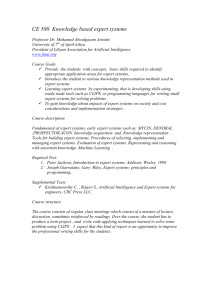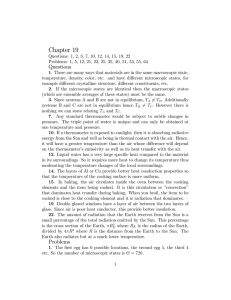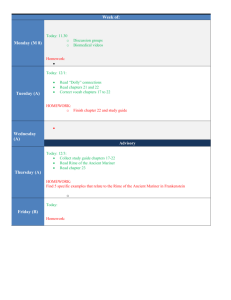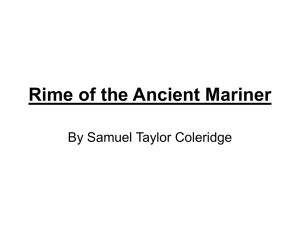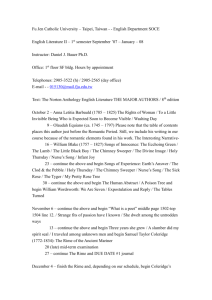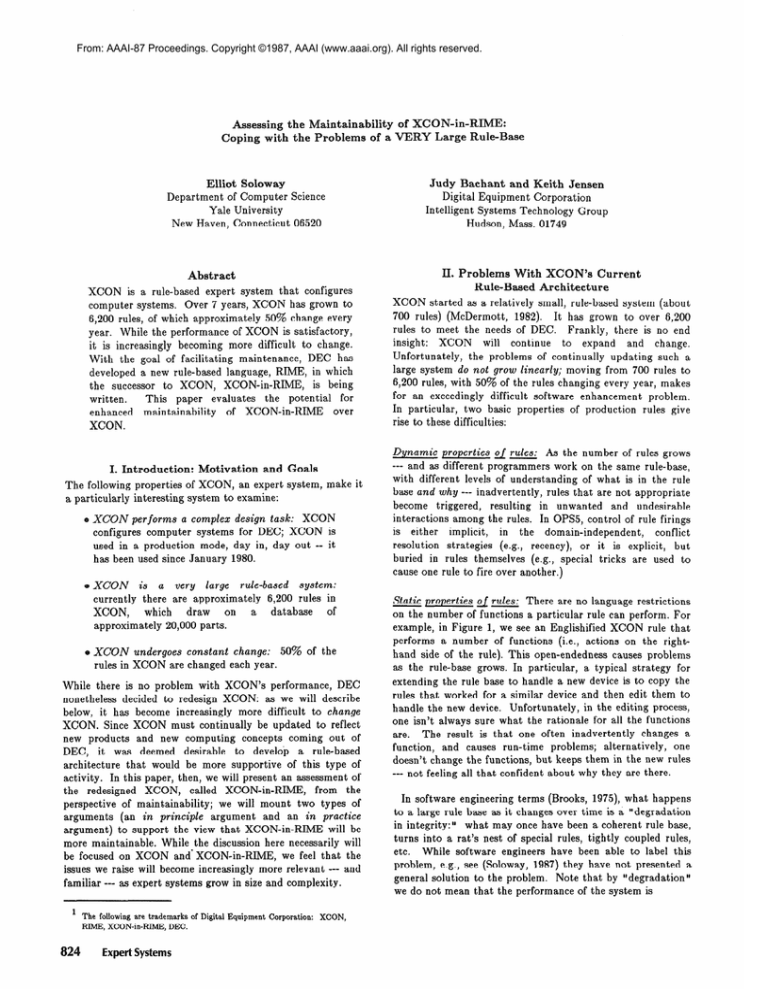
From: AAAI-87 Proceedings. Copyright ©1987, AAAI (www.aaai.org). All rights reserved.
Assessing the Maintainability
of XCQN-in-RIME:
Coping with the Problems of a VERY Large Rule-Base
Elliot Sollow ay
Department
of Computer
Yale University
New Haven, Connecticut
Judy
Bachant and Keith Jensen
Digital Equipment
Corporation
Intelligent
Systems Technology
Group
Hudson, Mass. 01749
Science
06520
II. Problems With XCQN’s
Current
Rule-Based Architecture
Abstract
XCON
is a rule-based
expert system
that configures
computer
systems.
Over 7 years, XCON has grown to
6,200 rules, of which approximately
50% change every
year.
While the performance
of XCON is satisfactory,
it is increasingly
becoming
more difficult
to change.
With the goal of facilitating
maintenance,
DEC has
developed
a new rule-based
language,
RIME, in which
the successor
to XCON,
XCON-in-RIME,
is being
This
paper
evaluates
the potential
for
written.
enhanced
maintainability
of XCON-in-RIME
over
XCON.
I. Introduction:
The following
a particularly
properties
interesting
Motivation
XCON started
as a relatively
small, rule-based
system (about
700 rules) (McDermott,
1982).
It has grown to over 6,200
rules to meet the needs of DEC.
Frankly,
there is no end
insight:
XCON
will
continue
to expand
and
change.
Unfortunately,
the problems
of continually
updating
such a
large system do not grow linearly;
moving from 700 rules to
6,200 rules, with 50% of the rules changing
every year, makes
for an exceedingly
difficult
software
enhancement
problem.
In particular,
two basic properties
of production
rules give
rise to these difficulties:
and Goals
of XCON, an expert
system to examine:
system,
make
it
e XCON
performs
a complex design task:
XCON
configures
computer
systems
for DEC; XCON
is
used in a production
mode, day in, day out -- it
1980.
has been used since January
e XCON
is
a
very
large
rule-based
system:
currently
there are approximately
6,200 rules in
which
draw
on
a
database
of
XCON,
approximately
20,000 parts.
o XCON
undergoes
constant
rules in XCON are changed
change:
each year.
5070 of the
While there is no problem
with XCON’s
performance,
DEC
nonetheless
decided
to redesign
XCON:
as we will describe
below, it has become increasingly
more difficult
to change
XCON.
Since XCON must continually
be updated
to reflect
new products
and new computing
concepts
coming
out of
DEC,
it was deemed
desirable
to develop
a rule-based
architecture
that would be more supportive
of this type of
activity.
In this paper, then, we will present an assessment
of
the redesigned
XCON,
called
XCON-in-RIME,
from
the
perspective
of maintainability;
we will mount
two types of
arguments
(an in principle
argument
and an in practice
argument)
to support
the view that XCON-in-RIME
will be
more maintainable.
While the discussion
here necessarily
will
be focused on XCON and‘ XCON-in-RIME,
we feel that the
issues we raise will become increasingly
more relevant
--- and
familiar --- as expert systems grow in size and complexity.
’ The following are
RIME,
824
trademarks
XCON-in-RIME,
DEC.
Expert Systems
of Digital
Equipment
Corporation:
XCON,
Dynamic
properties
OJ rules:
As the number of rules grows
_-- and as different
programmers
work on the same rule-base,
with different
levels of understanding
of what is in the rule
base and why --- inadvertently,
rules that are not appropriate
become
triggered,
resulting
in unwanted
and undesirable
interactions
among the rules. In OPS5, control of rule firings
is either
implicit,
in the
domain-independent,
conflict
resolution
strategies
(e.g., recency),
or it is explicit,
but
buried
in rules themselves
(e.g., special
tricks
are used to
cause one rule to fire over another.)
Static properties 0J rules: There are no language
restrictions
on the number of functions
a particular
rule can perform.
For
example,
in Figure 1, we see an Englishified
XCON rule that
performs
a number
of functions
(i.e., actions
on the righthand side of the rule). This open-endedness
causes problems
as the rule-base
grows. In particular,
a typical
strategy
for
extending
the rule base to handle a new device is to copy the
rules that worked for a similar device and then edit them to
handle the new device.
Unfortunately,
in the editing process,
one isn’t always sure what the rationale
for all the functions
The result is that one often inadvertently
changes
a
are.
function,
and causes
run-time
problems;
alternatively,
one
doesn’t change the functions,
but keeps them in the new rules
--- not feeling all that confident
about why they are there.
In software
engineering
terms (Brooks, 1975) what happens
to a large rule base as it changes over time is a “degradation
what may once have been a coherent
rule base,
in integrity:”
turns into a rat’s nest of special rules, tightly
coupled rules,
etc.
While software
engineers
have been able to label this
problem,
e.g., see (Soloway,
1987) they have not presented
a
general solution
to the problem.
Note that by “degradation”
we do not mean that the performance
of the system is
necessarily
impaired,
e.g., XCON continues
to function
quite
productively.
However,
from a rule-developer’s
perspective,
the rule-base
no longer has its initial unity of structure,
of
coherence,
thus making
additional
changes
increasingly
more
problematic.
Name: rl-unmounted-ubx-options
LHS: Describes certain types of cabinet mountable
disk drives and information necessary to place
one in a cabinet, cable it, and create output
RHS:
* identifies all of the information for
+ identifies the containing information
between the drive and cabinet,
* and creates output labeling
III.
1: An XCON
Rule
A New Language for Rewriting XCON:
RIME
XCON-in-RIME
is the successor
to XCON;
it will perform
the same function
as XCON but it is intended
to be more
maintainable,
i.e., its integrity
should be easier to preserve
over time.
RIME is the language
in which XCON-in-RIME
is
being written.
In turn, RIME produces
OPS5 code.
The
major advance of RIME over, say OPS5, is that one can more
easily make explicit domain knowledge,
both in structuring
of
the rules themselves
and in controlling
the firing of the rules.
(See also (van de Brug, et al., 1985, Chandrasekaren,
1983,
Neches,
et al., 1984, Clancey,
1983, Clancey
& Letsinger,
1981).)
Below, we identify
the more important
language
features
of RIME:
Problem
which
to
Space - provides
throw
rules that
a domain-specific
have a common
problem
space.)
there
are
Step:
then,
8 ELIMINATE
evaluate
the
that
domain-specific
rules
appropriateness
of the candidate
operators
and
prune the operators
down to one, e.g., in Figure 2
we present
a rule that decides among
the slots
being proposed.
the
selected
operator
is activated
o EVALUATE
Step: finally,
the goal is reviewed,
and if it has been achieved,
the problem space can
exited;
if the goal was not achieved,
then the
difficulty
is handled by going through
the problem
space once again, or by going to another
problem
space.
the drive to it's controller,
Figure
to go off to another
8 APPLY
Step:
and executed.
* Marks the drive "temporarily configured",
* marks the placement in the cabinet "used",
connecting
proposing
“bucket”
Note that within each step the actual order of “rule firing”
or activation
is irrelevant.
Control
is realized either by the
domain-independent
steps in a problem solving method or by
the domain-specific
task level control
of entering
another
problem space.
Subgroup - In order to help insure “one function,
one rule,”
there is an additional
Dewey-Decimal-like,
domain-specific,
classification
imposed on the rules: each class makes explicit
the function
that
the rule is performing.
For example,
in
Figure
3 we present
three rules, each of which performs
a
single function,
along with the subgroup
classification
scheme.
Note that this classification
scheme is not related to control
and implies nothing about the order of rule activation.
into
example,
in XCON-in-RIME,
there are 40 problem
spaces,
each dealing with one functional
aspect of the configuration
RuIe Type
- To help insure the creation
of rules
with
the categories
of permisable
rules,
there
templates
that serve as guides for rule creation.
problem,
e.g., CONFIGUREMODULE,
SELECT-MODULE,
SELECT-CONTAINER.
Some
problem
spaces
are
hierarchically
organized,
e.g.,
SELECT-MODULE
and
SELECT-CONTAINER
are functions
that must be done in
order to effectively
CONFIGUREMODULE.
With
this necessarily
brief
description
of XCON
and
XCON-in-RIME,
we can now proceed to assess the impact of
XCON-in-RIME’s
new architecture
on its maintenance.
purpose. For
Problem Solving Method - a domain-independent
sequence
of steps to solve a type of problem;
each problem space uses
one problem
solving method.
Of the 6 current
methods,
the
most frequently
used one is PROPOSE/APPLY,
which is, for
example,
the method
used for achieving
CONFIGURE
MODULE,
SELECT-MODULE,
and SELECT-CONTAINER.
In effect,
methods
explicitly
acknowledge
that
there
are
problem
solving
algorithms.
For
example,
in
the
PROPOSE/APPLY
method
there
are the following
steps
(note the following is a simplified
description):
@ PROPOSE
suggested
achievement
Step: first an operator
(or operators)
is
that
might
be
relevant
to
the
of the current
goal, e.g., in Figure 2
we present
two rules that suggest
might
be used in finding
a place
(Operators
typically
the example
above,
a slot that
for a drive.
either represent
objects,
as in
or actions,
as in the case of
consistent
are rule
IV. The Problems of Software Maintenance:
In General and In XCON
In a software
maintenance
task there is an existing
body of
code that must be augmented
in some manner.
Typically,
the
augmentation
is readily understood
--- the programmer
knows
what
needs
to be done.
However,
the
problem
is in
understanding
the existing
body of code, and then knowing
where and how to add the augmentation
so as not to disturb
the rest of the code. Thus, on the one hand, the maintainer’s
job will be facilitated
if the code is “readable,”
while on the
other hand, the code will remain in a readable
state if the
programming
language
facilitates
“good
programming
practice. 11 In effect, reading
and writing
are duals of each
readable
code.”
The
other, with the goal being “maintaining
enhance
the
will
what
then
is,
question,
Soloway, Bachant, and jensen
$25
readability/intelligibility
identified
that directly
Rule Name:
-select-drive-space:propose:
llOf:lowest-drive-slot
properties
of code? Two
influence this issue:
can
be
* Homogeneity.
a small
number
of readily
plans are used over and over again to
discernible
desired goals. A plan is a
accomplish
the various,
constructs
used
sequence
of
language
to
accomplish
some stereotypic
(i.e., oft occurring)
goal (Rich, 1981, Soloway
& Ehrlich,
1984).
In
contrast,
non-homogeneous
code
contains
idiosyncratic,
different
solutions
to similar
goals.
For example,
in the configuration
task, the code
of laying out a cabinet
for different
cabinets
and
should
still
have
some
different
computers,
common
appearance.
Afterall,
the goals that need
to be achieved
are similar.
Moreover,
a reader
should not be able to tell who wrote a particular
chunk
of code to realize
a particular
cabinet
layout; different
programmers
should be using the
set
of programming
plans
same
to
realize
comparable
goals.
LHS:
Identifies the lowest numbered drive
slot in the current cabinet
RHS:
Proposes that slot
Rule Name:
--
select-drive-space:propose:
llOj:exclusive-rackmount-drive-space
LHS:
Identifies a drive slot in which only
certain types of drives can be mounted
the current drive is one of those types
RHS:
Proposes that slot
Rule Name:
-select-drive-space:eliminate:
340c:prefer-exclusive-space
LHS:
e Predictability:
(1) the reader knows where to look
next for an answer to a question,
(2) the reader is
not surprised
by what he comes upon in the code,
can
trust
that
nothing
and
(3) the
reader
untoward
is being done behind
the scenes. For
example, if one rule (in the case of production
rule
programming)
serves more than one function,
then
point (3) may be violated.
Similarly,
if rules that
are intended
to serve
a related
function
are
distributed
over the rule base, the reader may not
realize he needs to look in a non-local
region for
key rules, and hence (1) may be violated.
Two proposed slots,
one of which has restricted use
RHS:
Eliminates the other slot
Figure
2:
Sample
XCON-in-RIME
Rules
Rule Name:
-configure-device:apply:
200a:mark-device-configured
LHS:
Unconfigured device chosen for activity
RHS:
Marks it's status "configured"
Rule Name:
-configure-device:apply:
420a:update-contained-number
LHS:
The current device has a "position-on-bus" identified
RHS:
That is the number used to identify this device
on the output by filling in "contained-number"
Rule Name:
configure-device:apply:
430a:update-containing-info
LHS:
The fact that the device being configured belongs
in a cabinet and the previously chosen cabinet
RHS:
Identifies that the device is contained in this cabinet
LEVEL 3
200
LEVEL 1
LEVEL 2
update-status-or-phase component
420
update-containership
contained
number
430
update-containership
containing
#
Figure 3:
Sample
Subgroup
Schema
-- Rule Type:
Apply
predictability
are related : by
and
Clearly,
homogeneity
and vice
code will be homogeneous,
definition,
predictable
versa. Homogeneity
focuses on a property
of the code itself,
while predictability
focuses on a property
of the use of the
code.
Those who have had to maintain
XCON
have repeatedly
(1) that
XCON
grows
continually
more nonobserved:
homogeneous,
and (2) that predictability
in the XCON ruleWhy? The basic problem seems
base is exceedingly
difficult.
to be the fact that what a code reader needs to know about a
in the rules; a
subset of rules, say, in XCON is not explicit
code reader needs to talk to the person who created the rules
memory”
of how the rules
and/or
tap into the “institutional
For example,
XCON
rule
evolved
to where
they
are.
tricks
to force rules to fire in a
developers
use various
And still further,
rule developers
use
particular
sequence.
Thus,
rule
certain
rules
for more
than
one purpose.
developers
are often uncertain
as to what XCON
rules are
really doing,
and therefore
they are afraid
to modify
the
rules,
lest some unwanted
behavior
might
result.
The
problem,
in a nutshell,
then, is that a rule developer
needs to
understand
at least a major portion of the rules before he can
effectively
make some change to the rule base.
We hasten
826
Expert Systems
to point
out that
XCON
rule developers
are not
malicious
individuals,
purposely
trying
to undermine
the
project
with
their
non-homogeneous,
idiosyncratic
code!
Rather,
the problem
is that there have been few external,
the
otherwise
implicit
explicit
mechanisms
to capture
knowledge.
For example,
the OPS5 language
encourages
the
style of programming
that has evolved,
e.g., there are no
effective
language
constructs
to aid the rule developer
in
creating
rules that do not have some order dependence.
Also,
coding practices
have evolved without
clear guidelines
as to
how rules should be written.
Again, this is not really a fault
the
rule
developers;
the
issues
of
homogeneity,
of
predictability,
and nature of the task (a very large rule-base
that continually
is modified) were not apparent
when XCON
started
to evolve. In fact, the lessons learned in working
on
XCON directly
lead to XCON-in-RIME
--- where weaknesses
of the sort identified
here are meant to be addressed.
that XCON is
The bottom
line is this: it is not surprising
very hard to maintain
(e.g, change,
add, delete rules): the
language
in which it is written,
the architecture
of the system
itself, and the coding guidelines
do not facilitate
rule change.
In what follows, we present
a rationale
for why XCON-inRIME does address
the specific
weaknesses
of XCON
and
thus why XCON-in-RIME
should be more maintainable
than
XCON.
V. In Principle: Why XCON-in-RIME
Should Be More Maintainable
Than XCON
Over
the years, the configuration
group at DEC has had the
a rule-base
architecture,
e.g.,
“push
around”
need
to
(Bachant
& McDermott,
1984). This extensive experience
has
led directly
to the design of RIME and to XCON-in-RIME.
In what
follows,
we identify
two major
factors
in which
RIME/XCON-in-RIME
differs from OPS5/XCON.
A. RIME
as a Higher-Order
Language
In order
to appreciate
the evolution
of RIME/XCON-inRIME from OPS5/XCON,
one needs to look to the history of
That
is,
the development
of programming
languages.
programming
languages
have continued
to evolve towards
FORTRAN
applications:
e.g.,
problem-specific
more
major
considered
a
TRANslation)
was
(FORmula
improvement
over assembly
language,
because
it allowed
scientists
to write
in
their
own,
natural
language:
Similarly,
APL, the new crop of
mathematical
equations.
spreadsheet
languages
(e.g.,
LOTUS,
MULTIPLAN),
etc.
have all been specifically
crafted
to allow domain
specialists
to talk to the computer
in a language
natural
to the domain.
It would
not be a distortion
to view OPS5
as at the
“assembly
language
level: ‘I afterall,
OPS5 is an almost totally
domain independent
programming
language,
which allows the
programmer
considerable
control,
and
hence
leeway.
In
contrast,
RIME has been designed specifically
to reflect what
has been learned about configuration,
and about writing
and
For example,
as mentioned
before,
changing large rule bases.
XCON rule developers
forced rules to fire in specific orders
and still attempted
to reuse subsets
of rules for multiple
goals. In contrast,
RIME attempts
to understand
this need
explicitly,
and has created explicit language
constructs
to deal
with this type of situation.
For inst#ance, notions
such as
problem space, problem solving
method,
method step, rule
type, have been created to help the rule developer
in making
explicit
the
heretofore
implicit
procedural
relationships
between rules.
Thus, RIME can be viewed as more towards
the “spreadsheet
end of the problem
independent/dependent
language
continuum.
‘1
As such,
then,
RIME
could
be
considered
a “higher-order
language”
in comparison
to OPS5,
much as FORTRAN
is considered
to be a “higher-order
language”
relative to assembly language.
The next question
is this: what predictions
can be made
about maintaining
XCON-in-RIME,
written
in RIME, on the
basis of experience
gained in maintaining
systems
written
in
other higher-order
languages ? In particular,
how do higherorder
languages
help with
respect
to homogeneity
and
predictability
of code?
8 Homogeneity:
The constructs
of a higher-order
language
can be viewed as techniques
for realizing
oft occurring
goals in the problems
towards
which
the language
is directed. Thus, similar problems
in
a domain
will have similar
solutions,
which
in
turn
makes
for more
homogeneous
and
less
idiosyncratic
code.
e Predictability:
Given that the language
constructs
are
more
directed
towards
problems
in the
domain,
the decomposition
in the code tends to
reflect
the decomposition
in the problems
more
explicitly.
Thus, it should be easier to identify
where subgoals
are achieved,
and hence where
code can be changed.
Given the positive effects promised
by the use of higher-order
languages,
it would be remiss on our part not to point out
that horrendous
looking code has been written
in higher-order
languages.
Nonetheless,
while hard numbers
are few and far
between,
the overwhelming
sense of the software
engineering
community
is that the use of higher-order
languages has had
a positive
impact
on maintenance,
e.g., (McGarry,
1982).
Thus, on these grounds alone, it is quite reasonable
to predict
that
XCON-in-RIME,
written
in RIME,
a higher-order
language,
should
be significantly
easier to maintain
than
XCON, written in a arguably
lower-level
language.
B. The Programming
Environment:
SEAR and Coding Guidelines
Language
constructs
are not enough
to ensure
that
rule
developers
use the constructs
in the desired fashion.
SEAR is
a tool being developed
that will directly interpret
RIME code.
Currently,
SEAR
provides
on-line
enforcement
of coding
guidelines,
e.g., there are templates
for each rule type which
guide the creation
of rules.
The coding guidelines,
and their
enforcement
via
SEAR,
correspond
to
“structured
programming”
practices
advocated
by
the
software
engineering
community
as leading
to more readable
code.
However,
unlike these vaguely worded practices,
SEAR’s can
be tuned to the specifics of the problem.
Soloway,
Bachant,
and Jensen
827
VI. In Practice:
For The Enhanced
Providing
Empirical
Maintainability
Support
of XCON-in-RIME
While an in principle
argument
needs to made, one would
like to see at least some glimmers
of evidence
for the
veracity
of those in principle
claims. In this section, then, we
present
empirical
evidence that does bolster the in principle
claims.
A. Data Collection
Observation
of the Rotaters:
Each rotater
had developed
special rule writing
‘Itricks” for creating
rules in XCON.
Methodology
Our goal was to get a sense of strengths
and weaknesses
of
XCON-in-RIME
from a user’s perspective.
We interviewed,
on a daily basis, 8 rule developers
who rotated
into the
XCON-in-RIME
project
for a short
period
of time (l-2
These
sessions
were
recorded
on audio-tape.
weeks).
Interview
data
of this sort does not provide
“statistical
anecdotal
evidence
of this
evidence”
pro or con. However,
sort has been found to be quite insightful
and reliable,
e.g.,
it does not
(Lewis, 1982, Littman,
et al., 1986). Frankly,
seem appropriate
at this stage to go to all the trouble
of
carrying
out a methodologically
rigorous,
controlled-study
--the costs would be to high, and the benefits
are not clear.
Note that the observations
described
below were made on the
basis
of
interviewing
only
4 rotaters.
However,
the
observations
made by the additional
4 rotaters
were in almost
unanimous
accord with those by the initial group of rotaters.
B. Observations On and Interpretations
Of
Rotaters’ Experiences with XCON-in-RIME
The following
is a distillation
of comments
made at the
various
debriefing
sessions with the rotaters.
In carrying
out
such
a
distillation,
there
is
always
the
danger
of
oversimplifying
or misrepresenting
someone’s
comments.
We
have, of course, attempted
to be as “fair” as we could in our
In what
follows,
we break
the rotaters’
interpretations.
comments
down with respect
to the issues of homogeneity
and predictability
of XCON-in-RIME
code.
Comments
accurately
assessed the content of the rules if the rules have a
homogeneous
nature.
One of the major readability
problems
with the current
rules in XCON is that rule developers
have
significant
difficulty
in figuring
out what is being implied by
the rules --- since different
rule developers
have different
styles of writing rules.
Interpretation:
We asked the various
rotaters
if they had
developed
any special techniques
for coding rules in XCON.
Each said they had.
For example,
one rotater
introduced
a
mini-context
mechanism
by including
a very general
rule at
the end of a set of rules; this general rule, then set a marker,
which,
in turn
would
allow another
set of rules to fire.
Another
rotater
included
extra conditionals
in his rule in
order to insure that that rule would fire at a special time.
Thus,
this point is similar
to the last point:
the rules in
XCON
were
often
coded
by
rule
developers
using
idiosyncratic
styles ---- thus, making the XCON rule base less
homogeneous
and less readable by other rule developers.
Observation
of the Rotaters:
were using typically
permitted
which rules were firing.
Interpretation:
While in their “pure” state, production
rules
are not meant to have this almost algorithmic
character,
the
reality
is that
problems
may
require
this
type
of
procedurality.
In XCON-in-RIME
this
procedurality
is
explicitly
acknowledged,
and the problem
spaces, steps, etc.
allow a rule developer
to explicitly
encode the sequentiality
that
they wanted
--- that
they were using
implicitly
in
XCON,
and doing so with various
coding
tricks.
Again,
readability
can only be enhanced
if rule developers
are given
tools --- the explicit vocabulary
of problems
spaces, steps, etc.
--- to help them in writing
rules. The use of this explicit
vocabulary
facilitates
the development
of a homogeneous
rule
set.
on Homogeneity:
Comments
Observation
rules. I’
of the Rotaters:
“I can’t
tell
who
wrote
different
rule developers
leads
directly
to the enhanced
readability:
when rule developer
X sits down to read the
current
rule base, he will feel more confident
that he has
Expert Systems
-on Predictability:
the
The rotaters
all agreed that the rules they
Interpretation:
read
in XCON-in-RIME
had
a certain
homogeneity.
In
contrast,
the rotaters
all agreed that, by and large, they could
tell who wrote a rule in XCON,
i.e., that rules could differ
substantially
as a function
of who wrote them.
We feel that
the homogeneity
in the rules in XCON-in-RIME,
in contrast
to XCON, is quite telling: a reasonable
interpretation
of this
difference
is that XCON-in-RIME
provides
constraints
and
guidelines
on the rule developers
so that they tend to write
The similarity
of the rules across
similar
looking
rules.
$28
The tricks the rule developers
them to control
the order in
Observation
of the Rotaters:
base to add some new rule. ”
Interpretation:
A
rotaters
was they
needed to make a
contrast,
a major
difficulty
in locating
made.
Observation
organized. ‘I
of
“I know where
to go in the rule
comment
made almost universally
by the
felt that they could pinpoint
where they
change in XCON-in-RIME’s
rule base. In
problem
with XCON’s
rule base was the
the place where the change needed to be
the
Rotaters:
“The
rules
are
more
Interpretation:
By and large the rotaters
all said something
like the above statement.
In unpacking
what it means to be
“organized,
” it appeared
that the rotaters
felt that rules had
those
familiar
with
the
to
be,
i.e.,
specific
places
task
found
the problem
spaces,
subgroup
configuration
classification
scheme, etc. to be natural,
organizational
units.
Again, this observation
reflects both a broader
understanding
of the task of configuration
as well as the encoding
strategy
dictated
by the design of XCON-in-RIME,
i.e., the fact that
there are multiple classification
levels using explicit criteria.
Bachant,
J., McDermott,
J. Rl Revisited:
Four
Trenches.
AI Magazine,
1984, S(S), .
Brooks,
The Mythical
F.
Publishing
Co., 1975.
Man-Month.
Years
Addison-Wesley
Towards
a Taxonomy
of
Chandrasekaren,
B.
Solving Types.
Al Magazine,
1983, 4(l), .
VII.
Concluding
Remarks
Based on the two types of arguments
just presented,
there is
clearly a prima facie case that:
XCON-in-RIME
should be
While
that
difference
easier
to maintain
than XCON.
should be readily
observable,
it would nonetheless
be more
than academic
to gather data on two types of measures:
e Human
performance:
change/add
a rule(s)?
How long does it take
How long does it take to
How many bugs are made?
to identify and fix bugs?
GBAssessing
readability
status
of rule base:
the
rule
base
degrade
as
new
rules
added/changed?
How homogeneous
are the
after 6 months,
12 months, etc.?
Does
are
rules
However,
in order to capture
such data, we would first need
to define
some
metrics
(e.g.,
how
does
one
quantify
homogeneity?).
Moreover,
we should not expect that all the
maintenance
problems
will be alleviated
by XCON-in-RIME;
afterall,
there are many problems
yet to be discovered
(e.g.,
what happens
when the rule base hits 18,000 rules? 27,000
rules?).
Finally,
economic reasons dictate that an evaluation,
of the
sort described
here, be carried
out before one undertakes
a
redesign/reimplementation
of a system of the magnitude
of
XCON.
Moreover,
as expert
systems
continue
to become
more of an engineering
enterprise,
we will need to develop a
range of evaluation
tools: evaluation
is an integral part of
Thus, besides evaluating
XCON-inan engineering
effort.
RIME’s design, we have attempted
to articulate
one strategy
for carrying
out a design evaluation:
in principle
and in
practice type arguments.
Acknowledgements
We would like to thank Diane Muise and Michael Grimes for
their
continuing
contributions
to the RIME Project,
and
Virginia
Barker
and Dennis O’Connor
for their unflagging
support,
encouragement,
and above all, patience.
Clancey,
W.
Knowledge
the AAAI
1983.
The
Advantages
in Expert System
National
Conference
in the
Problem
of Abstract
Control
Design.
Proceedings
of
on AI, Washington,
DC,
NEOMYCIN:
Reconfiguring
a
Clancey,
W., Letsinger,
R.
Rule-based
Expert System for Application
to Teaching.
Proceedings
of the Seventh IJCAI Conference,
1981.
Lewis,
C. Using the “Thinking-aloud
n Method in Cognitive
Interface
Design.
Technical
Report RC 9265, IBM
Watson Research Center, Yorktown
Heights, NY., 1982.
Littman,
D., Pinto,
J., Letovsky,
S., Soloway,
E.
Software
Maintenance
and Mental
Models.
In Soloway,
E.,
Iyengar,
S. (Eds.), Empirical
Studies
of Programmers,
Ablex, Inc., 1986.
McDermott,
J.
Rl: A Rule-based
Configurer
of Computer
Systems.
Artificial
Intelligence,
1982, 19, .
McGarry,
F. What We Have
Measuring
Software
Proceedings
on Software
Learned In The Past 6 Years:
Development
Technology.
of the Seventh
NASA/Goddard
Engineering,
Md., 1982.
Workshop
Neches, R, Swartout,
W., Moore, J. Enhanced
Maintenance
and Explanation
of Expert Systems
Through Explicit
Models
of Their Development.
Proceedings
of the
IEEE
Workshop
on Principles
of Knowledge-based
Systems, Denver, CO, 1984.
Rich,
C. Inspection
Methods
in Programming.
Report AI-TR-604,
MIT AI Lab, 1981.
Technical
Soloway,
E.
“I Can’t Tell What In The Code Implements
What In The Specs n.
Proceedings
of the Second
International
Human-Computer
Interaction
Conference,
Honolulu,
Hawaii, 1987.
Soloway,
E., Ehrlich,
K. Empirical
Studies
Knowledge.
IEEE
Transactions
Engineering,
1984, SE-10(5), 595-609.
of Programming
on
Software
van de Brug, A., Bachant,
J., McDermott,
J. Doing R1 With
Style.
Proceedings
of the Second IEEE Conference
on
AI Applications,
Miami, FL, 1985.
Soloway,
Bachant,
and jensen
$29



